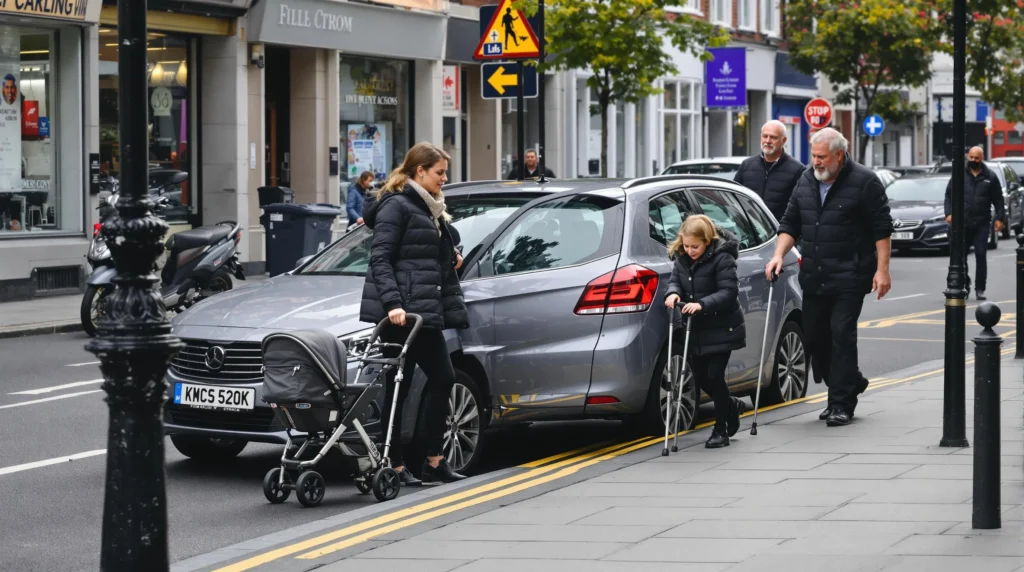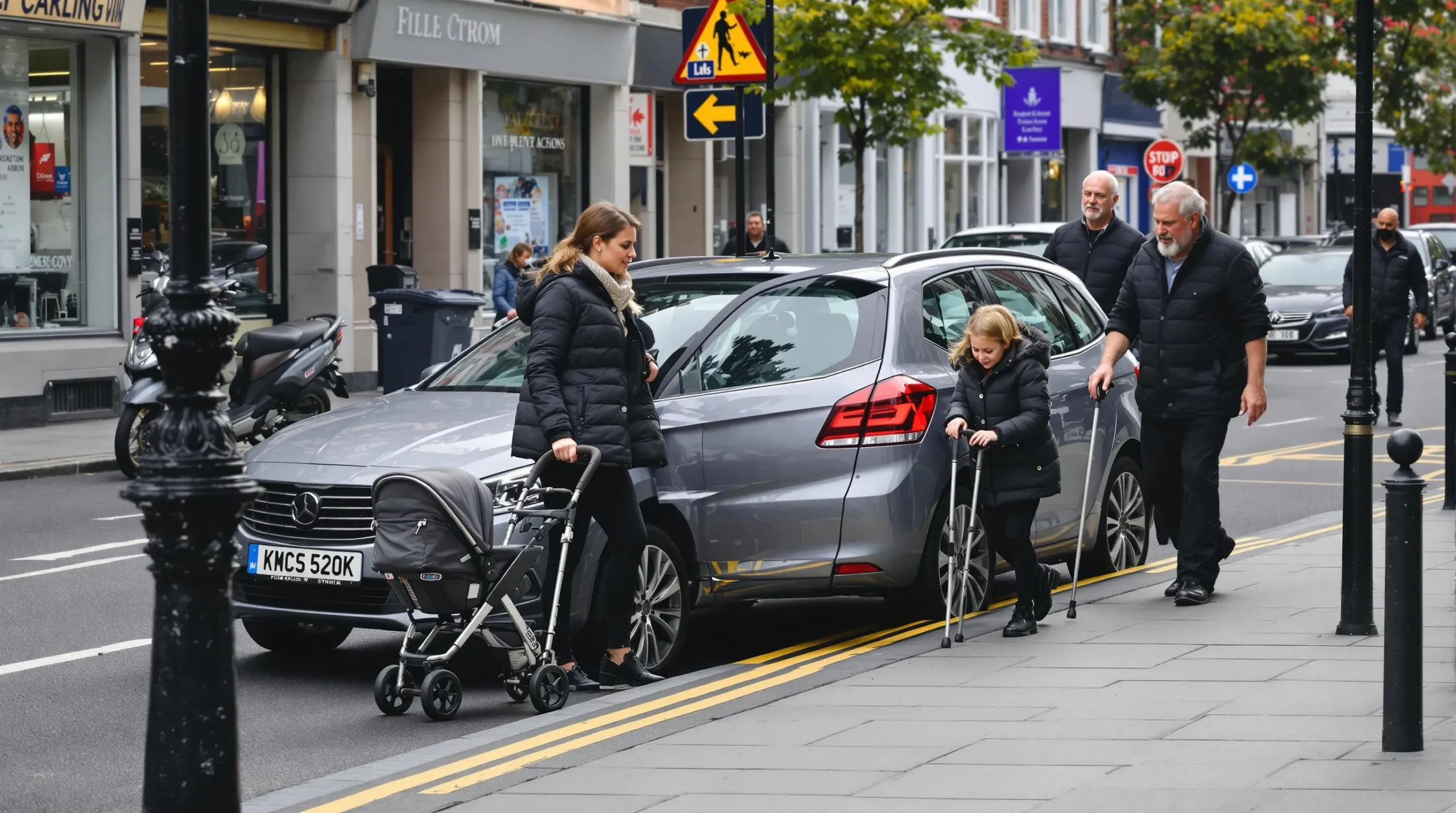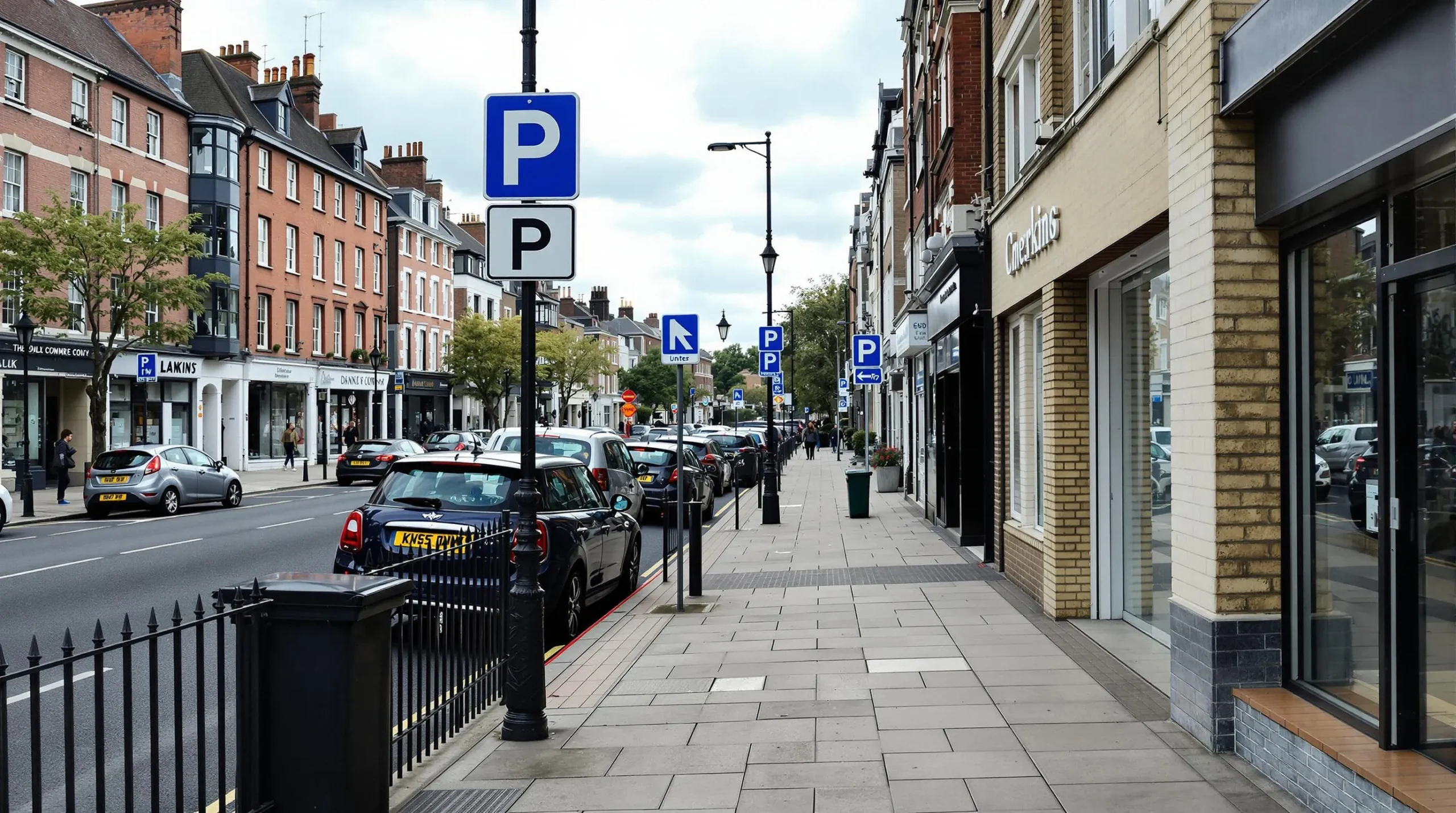Is It Illegal to Park on the Pavement? UK Laws, Fines & Penalties Explained

This post was originally published on this site
The post Is It Illegal to Park on the Pavement? UK Laws, Fines & Penalties Explained appeared first on UK Construction Blog.
Key Takeaways
- Pavement parking laws vary dramatically across the UK: London has a complete ban with £40-£130 fines, Scotland implemented a nationwide prohibition in December 2023 with £100 fines, whilst England and Wales rely on a patchwork of local council regulations
- Scotland leads with comprehensive legislation: The Transport Scotland Act 2019 prohibits pavement parking, double parking, and blocking dropped kerbs across all Scottish councils, making it the first UK nation with blanket restrictions outside London
- Vulnerable road users face serious safety risks: Pavement parking forces wheelchair users, parents with pushchairs, and visually impaired pedestrians into dangerous road situations, often completely blocking their access routes
- Infrastructure damage costs councils millions: Pavements designed for pedestrian loads suffer significant structural damage from vehicle weight, with repair costs reaching £50-£150 per square metre and contributing to a £1 billion maintenance burden
- England may introduce national ban: Government consultations indicate strong support for London-style blanket prohibition across England, with implementation expected within 2-3 years subject to parliamentary approval
- Report violations with photographic evidence: Contact your local council with clear images showing vehicle position, registration details, exact location, and timestamp to ensure effective enforcement action
Picture this: you’re rushing to drop off a parcel and spot what seems like the perfect parking space – half on the pavement, half on the road. It’s convenient, quick, and everyone else seems to be doing it. But that seemingly harmless decision could land you with a £100 fine and potentially endanger vulnerable pedestrians.
The reality of pavement parking laws across the UK isn’t as straightforward as you might think. While Scotland has introduced blanket prohibitions under the Transport Scotland Act 2019, England and Wales operate under a patchwork of local regulations that vary dramatically from one council to another.
Understanding these rules isn’t just about avoiding penalties – it’s about recognising how your parking choices affect wheelchair users, parents with pushchairs, and visually impaired pedestrians who rely on clear, accessible pavements for safe navigation.
Is It Illegal to Park on the Pavement?
Pavement parking legality varies significantly across the UK’s different regions. Each country and local authority applies different rules and enforcement approaches.
Current Legal Status Across the UK
Parking on pavements isn’t universally illegal throughout the UK. England and Wales operate under a patchwork system where local councils determine enforcement priorities and restrictions.
Highway Code Rule 244 states drivers “MUST NOT park partially or wholly on the pavement in London” but “should not do so elsewhere unless signs permit it.” This distinction between “must not” and “should not” creates confusion for drivers outside London.
Local councils in England and Wales can issue fines for pavement parking if:
- Signs specifically prohibit it
- Yellow lines or other parking restrictions apply
- The vehicle obstructs pedestrian access
- Police consider it an unnecessary obstruction
Heavy goods vehicles exceeding 7.5 tonnes face stricter rules. These vehicles cannot park on pavements anywhere unless loading operations require it.
Most enforcement outside London depends on police action for “unnecessary obstruction of the highway.” But, police rarely prosecute these cases due to unclear legislation and prosecution difficulties.
London’s Specific Regulations
London maintains the strictest pavement parking laws in the UK. The Greater London General Purposes Act 1974 and Highway Code Rule 244 combine to create an absolute prohibition.
Parking partially or wholly on pavements anywhere in London results in a £70 penalty charge notice. This fine applies regardless of whether signs indicate the restriction.
London’s rules include specific exceptions. You can park on pavements if:
- Road signs explicitly permit it
- The road would become impassable to traffic otherwise
- Loading operations require temporary pavement access
Traffic wardens and parking attendants actively enforce these regulations throughout London’s 32 boroughs. The consistent enforcement makes London unique compared to other UK regions.
Scotland’s Pavement Parking Ban
Scotland implemented comprehensive pavement parking legislation through the Transport Scotland Act 2019. The ban took effect on 11 December 2023 across all Scottish local authorities.
The Scottish legislation prohibits three specific parking behaviours:
- Parking on pavements (footways)
- Double parking alongside other parked vehicles
- Parking across dropped kerbs used by pedestrians and cyclists
Local authorities can issue £100 penalty charge notices for violations. The fine reduces to £50 if paid within 14 days. Enforcement began in different areas at varying times, with Perth and Kinross starting enforcement on 6 January 2025.
Scotland’s approach aims to protect vulnerable road users including wheelchair users, parents with pushchairs, and visually impaired pedestrians. The legislation recognises that footways aren’t designed to support vehicle weight and persistent parking causes pavement damage.
The national parking campaign raised awareness about these changes before enforcement began. This comprehensive approach makes Scotland the first UK country to carry out blanket pavement parking restrictions outside London.
Understanding Pavement Parking Laws

Pavement parking laws in the UK operate through multiple legal frameworks that create different enforcement powers across regions. These laws determine how authorities can issue fines and what constitutes a parking violation.
Unnecessary Obstruction of the Highway
Unnecessary obstruction of the highway forms the foundation of pavement parking enforcement outside London and Scotland. Section 137 of the Highways Act 1980 makes it illegal to obstruct the highway without lawful authority, which includes both roads and pavements.
You can face prosecution if your parked vehicle creates an unnecessary obstruction that prevents pedestrians from using the pavement safely. This law applies particularly when your car forces wheelchair users onto the road or blocks pushchair access completely. Police officers typically handle these cases under criminal law rather than civil enforcement.
Regulation 103 of the Road Vehicles (Construction and Use) Regulations 1986 specifically targets motor vehicle obstruction. The challenge lies in proving “unnecessary” obstruction since each case requires individual assessment rather than blanket application.
| Legislation | Enforcement Authority | Penalty Type |
|---|---|---|
| Highways Act 1980 Section 137 | Police | Criminal prosecution |
| Road Vehicles Regulations 1986 | Police | Fixed penalty or court |
| Traffic Management Act 2004 | Council officers | Civil fine |
Civil Parking Enforcement Powers
Civil Parking Enforcement Officers can issue Penalty Charge Notices for specific pavement parking violations where local restrictions exist. These officers work for council authorities and focus on clearly defined parking contraventions rather than general obstruction.
You’ll receive a Penalty Charge Notice when parking violates Traffic Regulation Orders or designated parking bays. Unlike police enforcement this system operates during standard working hours and targets visible parking violations with clear signage.
Edinburgh implemented civil enforcement powers for pavement parking in January 2024 with £100 fines reduced to £50 if paid within 14 days. Perth and Kinross began enforcement on 6th January 2025 following the same penalty structure.
Council enforcement differs from police action because it focuses on administrative violations rather than criminal obstruction. Officers can issue immediate fines without requiring court proceedings or proving intent to obstruct.
Traffic Regulation Orders
Traffic Regulation Orders allow local councils in England and Wales to prohibit pavement parking on specific streets or areas. These orders create enforceable restrictions backed by clear signage and road markings.
You’ll find TRO restrictions marked with signs and yellow lines that indicate where pavement parking becomes a civil offence. Councils typically carry out these orders in response to persistent parking problems or accessibility concerns in particular locations.
The TRO process requires public consultation and can take approximately 2 years to complete. Implementation costs reach £1000 per street for signs consultation and legal processes making this approach expensive for widespread use.
Local authorities outside London rely heavily on TROs because they lack blanket pavement parking powers. This creates a patchwork system where identical streets in different areas have completely different parking rules.
TRO enforcement enables councils to issue £70 fines through Civil Enforcement Officers rather than relying on infrequent police action. But this system only works where councils have invested in creating specific local restrictions rather than addressing pavement parking comprehensively.
Regional Differences in Enforcement

Enforcement of pavement parking laws varies dramatically across the UK, creating a complex web of regulations that drivers must understand. Each region operates under different legal frameworks and penalty structures that reflect local priorities and legislative powers.
Why London and Scotland Are Different
London established its pavement parking prohibition in 1974 through the Greater London General Purposes Act, making it the UK’s first region to carry out comprehensive restrictions. Highway Code Rule 244 explicitly states that you must not park partially or wholly on the pavement in Greater London, with fines ranging from £40 to £130 depending on the specific violation.
Scotland took a different legislative approach through the Transport Scotland Act 2019, which came into effect on 11 December 2023. This Act creates a blanket prohibition across all Scottish local authority areas, with standardised £100 fines reduced to £50 if paid within 14 days. Edinburgh began enforcing these rules in January 2024, followed by other councils implementing their own enforcement schedules.
The key difference lies in legislative authority. London’s ban operates under specific Greater London legislation, whilst Scotland’s prohibition stems from national Scottish law that applies uniformly across all 32 local authority areas. Both regions can issue Penalty Charge Notices through Civil Parking Enforcement Officers without requiring police involvement.
| Region | Legal Framework | Fine Amount | Enforcement Body |
|---|---|---|---|
| London | Greater London General Purposes Act 1974 | £40-£130 | Council parking officers |
| Scotland | Transport Scotland Act 2019 | £100 (£50 if paid early) | Local authority officers |
Rest of England and Wales Approach
England and Wales (excluding London) operate under a fragmented system where local councils determine their own enforcement priorities. Highway Code Rule 244 uses advisory language, stating you should not park on pavements unless signs permit it, but this creates no automatic legal prohibition.
Local councils can create Traffic Regulation Orders (TROs) to prohibit pavement parking in specific areas, typically combining these restrictions with Controlled Parking Zones or yellow line restrictions. Birmingham, Manchester, and Bristol have implemented targeted pavement parking prohibitions in city centres and residential areas with high pedestrian traffic.
96% of local authorities in England now have Civil Parking Enforcement powers, allowing them to issue Penalty Charge Notices for parking violations. But, councils must invest significant resources in creating TROs and installing appropriate signage before they can enforce pavement parking restrictions.
Police retain responsibility for enforcing obstruction offences under Section 137 of the Highways Act 1980, but prosecution rates remain low due to resource constraints and evidential requirements. You can still receive a fine if your parked vehicle creates a dangerous obstruction or forces pedestrians into the roadway, regardless of local council policies.
Wales has proposed legislation to grant local authorities enhanced powers to address pavement parking without requiring individual TROs, but implementation timelines remain unclear. Northern Ireland follows similar principles to England, with parking restrictions on yellow lines extending to adjacent pavements, but lacks comprehensive pavement parking legislation.
Penalties and Fines for Pavement Parking

Pavement parking fines vary significantly across the UK depending on location and enforcement authority. Understanding these penalty structures helps you budget for potential violations and make informed parking decisions.
Current Fine Amounts
London imposes the steepest penalties for pavement parking violations. Fines range from £40 to £130 depending on the specific offence and location within the borough. Central London typically carries higher penalties than outer boroughs.
Edinburgh enforces a standardised £100 fine for pavement parking since January 2024. This penalty reduces to £50 if you pay within 14 days of receiving the notice.
Scotland (excluding Edinburgh) maintains consistent penalties across all local authorities under the Transport Scotland Act 2019. The standard fine is £100, reduced to £50 for early payment within the specified timeframe.
England and Wales (excluding London) operate under varied penalty structures set by individual local councils. Fixed Penalty Notices typically range from £50 to £70 when issued by police. Penalty Charge Notices from local councils vary between £50 to £130 depending on the area and specific violation.
| Location | Standard Fine | Early Payment | Issuing Authority |
|---|---|---|---|
| London | £40-£130 | Varies by borough | Local councils |
| Edinburgh | £100 | £50 (within 14 days) | Edinburgh Council |
| Scotland (other areas) | £100 | £50 (within 14 days) | Local authorities |
| England/Wales | £50-£130 | Varies | Police/councils |
Additional penalties may apply if pavement parking causes obstruction. Police can issue penalty points on your licence alongside monetary fines in severe cases involving dangerous obstruction.
How to Appeal a Penalty Notice
Don’t pay immediately if you intend to challenge the penalty. Payment constitutes admission of guilt and prevents further appeals.
Valid grounds for appeal include:
- Vague or obscured parking signs that didn’t clearly indicate restrictions
- Emergency situations requiring immediate roadside stopping
- Medical emergencies or sudden illness whilst driving
- Moving off the carriageway to avoid obstructing traffic flow
- Allowing emergency vehicles to pass safely
- Errors on the penalty notice itself
Gather supporting evidence before submitting your appeal. Photograph unclear signage, document the emergency situation, or collect witness statements. Check the penalty notice for administrative errors such as incorrect vehicle details, wrong location, or inaccurate timing.
Submit your appeal to the issuing authority within the specified timeframe, usually 28 days from the notice date. Include all supporting evidence and provide a clear explanation of why you believe the penalty was issued incorrectly.
Escalate if rejected by requesting an independent review. Most areas offer tribunal services or independent adjudicators who review contested penalties. This process is typically free and conducted by postal correspondence.
Consider legal advice for complex cases involving multiple violations or significant financial penalties. Some motoring organisations provide free legal guidance for members facing parking disputes.
Response timeframes vary by authority, but you should receive acknowledgement within 14 days and a decision within 56 days of submitting your appeal.
Problems Caused by Pavement Parking

Pavement parking creates serious problems that affect pedestrians, accessibility, and public infrastructure. These issues demonstrate why strict enforcement remains essential across the UK.
Impact on Pedestrians
Pavement parking forces pedestrians into dangerous situations by blocking their designated walking space. When you park on the pavement, pedestrians must step into busy roads to navigate around your vehicle, dramatically increasing their risk of accidents.
Children face particular dangers when forced to walk in traffic around parked cars. Their smaller stature makes them less visible to oncoming drivers, while their unpredictable movements can lead to serious collisions. Elderly pedestrians also struggle with the sudden need to step into roads, as their slower reaction times and reduced mobility make quick decisions more challenging.
The psychological impact affects many pedestrians who feel intimidated by having to enter traffic unexpectedly. Visually impaired individuals experience heightened anxiety when their usual walking routes become unpredictable obstacles courses, often leading them to avoid certain areas entirely.
Accessibility Issues for Disabled Users
Disabled users face the most severe consequences from pavement parking, with wheelchair users often finding their routes completely blocked. Standard wheelchair widths require approximately 800mm of clear space, but parked vehicles frequently leave gaps of just 600mm or less, making passage impossible.
People using mobility scooters encounter similar barriers, as these devices typically measure 650-700mm wide and cannot easily manoeuvre around parked cars. The forced detour into roads becomes particularly dangerous for those with slower-moving mobility aids who cannot quickly escape oncoming traffic.
Parents pushing prams also struggle with reduced pavement space, as standard pushchairs require roughly 600mm width for comfortable passage. Double buggies, measuring up to 800mm wide, face the same complete blockages as wheelchair users.
Visual impairment creates additional complications when familiar routes suddenly change due to parked vehicles. Guide dogs trained to navigate specific paths become confused by unexpected obstacles, while white cane users lose their reference points when forced to navigate around cars.
| User Group | Space Required | Common Impact |
|---|---|---|
| Wheelchair users | 800mm | Complete blockage |
| Mobility scooter users | 650-700mm | Forced road use |
| Parents with prams | 600mm | Dangerous detours |
| Double buggy users | 800mm | Complete blockage |
Damage to Infrastructure
Pavements aren’t designed to support vehicle weight, leading to significant structural damage when cars park on them regularly. According to industry contractors he typical pavement construction uses materials and depths suitable for pedestrian loads of around 5kN per square metre, while cars exert pressures of 150-200kN per square metre through their tyres.
Cracked paving stones and damaged kerbs result from this excessive weight, creating trip hazards that pose risks to all pedestrians. Local authorities spent approximately £1 billion between 2006 and 2012 repairing pavement damage, with much of this cost attributed to vehicle-related deterioration.
Underground utilities suffer damage when heavy vehicles compress the ground above water pipes, gas lines, and electrical cables. These repairs often require expensive excavation work and can disrupt essential services for entire neighbourhoods.
Surface deterioration accelerates dramatically under vehicle weight, with standard concrete slabs developing stress fractures within months rather than their intended decades of pedestrian use. Asphalt surfaces fare even worse, developing permanent depressions and soft spots that collect water and create further structural problems.
The cumulative maintenance costs burden local council budgets, diverting funds from other essential services. Each damaged pavement section typically costs £50-£150 per square metre to repair properly, making prevention through strict parking enforcement more economical than ongoing repairs.
Proposed Changes to UK Law

The UK government recognises the urgent need for comprehensive pavement parking legislation across England. Multiple consultation rounds have explored various approaches to create consistent enforcement powers for local authorities nationwide.
Government Consultation Options
The Department for Transport has evaluated three distinct approaches to tackle pavement parking across England. The first option focuses on improving Traffic Regulation Orders (TROs) to help councils manage local parking issues more effectively. This streamlined process would reduce the current 18-month timeline for implementing new parking restrictions.
The second option proposes decriminalising obstruction offences, allowing councils to issue Penalty Charge Notices directly rather than relying on police enforcement. Currently, only 5% of drivers understand existing pavement parking laws, making consistent civil enforcement essential for compliance.
The third option involves implementing a London-style blanket prohibition across England, similar to Scotland’s comprehensive ban. This approach would eliminate confusion about where pavement parking is permitted and create uniform enforcement standards nationwide.
Public consultation responses exceeded government expectations, with tens of thousands of submissions received. The overwhelming majority supported stronger enforcement measures, particularly from disability rights groups and pedestrian safety organisations who highlighted accessibility concerns.
Potential National Ban
England moves closer to implementing a nationwide pavement parking prohibition following Scotland’s successful legislative model. The proposed ban would align England with existing restrictions in London and Scotland, creating consistent rules across Great Britain.
Parliamentary discussions indicate strong support for comprehensive legislation targeting pavement parking, double parking, and dropped kerb violations. The Transport Committee’s 2019 inquiry specifically recommended national prohibition to protect vulnerable road users and reduce infrastructure damage.
Local authority surveys reveal widespread support for enhanced enforcement powers, with 96% of councils already possessing Civil Parking Enforcement capabilities. A national ban would expand these powers to cover obstruction offences currently handled by overstretched police resources.
The proposed legislation includes exemptions for emergency vehicles, essential deliveries, and specific circumstances designated by local authorities. These provisions address concerns raised during the failed 2015 Private Members’ Bill about narrow residential streets without off-street parking alternatives.
Timeline for Legal Changes
Scotland’s enforcement began in December 2023, with councils across the country implementing £100 fines for pavement parking violations. East Dunbartonshire and Fife councils introduced warning periods before full enforcement, demonstrating the phased approach many authorities adopted.
England’s timeline remains under parliamentary review, with extended consultation responses delaying final decisions until 2025. The government aims to ensure comprehensive legislation that addresses regional variations and implementation challenges identified in Scotland’s early enforcement period.
Local councils can already carry out pavement parking restrictions through TROs, but national legislation would standardise penalties and enforcement procedures. Current fines range from £40 to £130 across different English councils, creating inconsistent deterrent effects.
Wales continues exploring enhanced local authority powers through separate legislative processes, while Northern Ireland maintains its current framework pending wider UK developments. The coordinated approach across Great Britain suggests implementation within the next 2-3 years, subject to parliamentary approval and resource allocation for enforcement infrastructure.
How to Report Pavement Parking

Report pavement parking violations directly to your local authority through their designated channels. Most councils provide multiple contact methods including online forms, dedicated apps, telephone services, and email systems.
Local Authority Procedures
Contact your local council’s parking enforcement team through their official website or customer service line. London boroughs operate dedicated reporting systems with streamlined processes for pavement parking complaints, processing reports within 2-5 working days depending on the area.
Submit your report with complete details including the vehicle’s registration number, exact location using street names or postcodes, and the specific time and date of the violation. Edinburgh City Council processes reports through their MyEdinburgh app, whilst Glasgow uses their online reporting portal for efficient case management.
Follow up on your report using the reference number provided by the council. Most authorities acknowledge complaints within 24-48 hours and investigate reports based on available evidence and enforcement officer schedules.
Check your council’s specific procedures as enforcement approaches vary significantly across different regions. Some councils prioritise reports based on safety concerns, focusing on violations that block wheelchair access or create pedestrian hazards.
What Evidence Is Needed
Photograph the vehicle clearly showing its position on the pavement with identifiable landmarks or street signs visible in the frame. Capture multiple angles demonstrating the extent of the obstruction and its impact on pedestrian access.
Record the vehicle’s registration plate, make, model, and colour in your photographic evidence. Include a timestamp showing the date and time of the violation, either through your camera’s automatic settings or by photographing a watch or mobile phone display.
Document the specific location using street names, house numbers, or notable landmarks that enforcement officers can easily identify. GPS coordinates from your smartphone provide additional precision for council records.
| Evidence Type | Requirements | Purpose |
|---|---|---|
| Photographs | Clear images showing vehicle position | Visual proof of violation |
| Registration Details | Complete number plate information | Vehicle identification |
| Location Data | Street name, postcode, landmarks | Enforcement officer guidance |
| Time Stamp | Date and exact time of offence | Violation documentation |
| Obstruction Impact | Width of remaining pavement space | Safety assessment |
Measure the remaining pavement width if possible, as councils often require evidence that pedestrian access is significantly compromised. Standard pavement widths vary between 1.5-2 metres, and obstructions leaving less than 1 metre of clear space typically receive priority attention.
Provide witness statements if other pedestrians experienced difficulties navigating around the parked vehicle. Written accounts from wheelchair users, parents with pushchairs, or visually impaired individuals strengthen your report considerably.
Conclusion
You now have a clear understanding of where pavement parking stands legally across the UK. The patchwork of regulations means you’ll need to stay informed about your local area’s specific rules and enforcement policies.
Scotland’s comprehensive approach and London’s strict penalties demonstrate how effective consistent legislation can be. As England moves towards nationwide prohibition by 2025 you can expect clearer guidelines and more uniform enforcement.
Your parking choices directly affect pedestrian safety and accessibility. By staying informed about local regulations and considering the impact on vulnerable road users you’re contributing to safer streets for everyone.
Remember that reporting violations through proper channels helps authorities understand problem areas and allocate enforcement resources effectively.
Frequently Asked Questions
Is pavement parking illegal in the UK?
Pavement parking legality varies across the UK. In London, it’s completely prohibited under Highway Code Rule 244. Scotland implemented a blanket ban in December 2023 with £100 fines. In England and Wales outside London, it’s generally not permitted, but enforcement depends on local council regulations and Traffic Regulation Orders.
What are the penalties for pavement parking?
Penalties vary significantly by region. London imposes fines ranging from £40 to £130. Scotland enforces standardised £100 fines (reduced to £50 for early payment). In England and Wales, individual councils set their own penalty structures, though enforcement remains inconsistent due to resource constraints and unclear legislation.
Can I appeal a pavement parking fine?
Yes, you can appeal penalty notices within specified timeframes. Valid grounds include unclear signage, emergency circumstances, or procedural errors. Gather photographic evidence, witness statements, and documentation supporting your case. Submit appeals through the issuing authority’s official channels, following their specific procedures and deadlines.
How do I report pavement parking violations?
Contact your local authority through online forms, dedicated mobile apps, or telephone hotlines. Provide comprehensive details including vehicle registration, exact location, time and date, and photographic evidence. Include timestamps and any witness statements to strengthen your report and improve enforcement likelihood.
Why is pavement parking problematic?
Pavement parking forces pedestrians into dangerous road situations, particularly affecting children, elderly individuals, and disabled users. Wheelchair and mobility scooter users often find routes completely blocked. Additionally, vehicles damage pavements not designed to support their weight, creating costly repair burdens for local councils.
What exemptions exist for pavement parking?
Emergency vehicles typically have exemptions when responding to incidents. Some proposed legislation includes allowances for essential deliveries in narrow residential streets without alternatives. However, exemptions are limited and specific, with most requiring official permits or clear signage indicating permitted parking areas.
When will England implement nationwide pavement parking laws?
Parliamentary discussions indicate comprehensive legislation is under review, with final decisions expected by 2025. The proposed laws would create consistent enforcement powers similar to Scotland’s model, targeting pavement parking, double parking, and dropped kerb violations. Implementation timeline suggests 2-3 years, subject to parliamentary approval.
What evidence is needed to report pavement parking?
Effective reports require vehicle registration numbers, precise location details, date and time stamps, and clear photographic evidence. Include multiple angles showing the obstruction, any relevant signage, and the impact on pedestrian access. Witness statements and documentation of repeated violations strengthen enforcement cases.





Responses